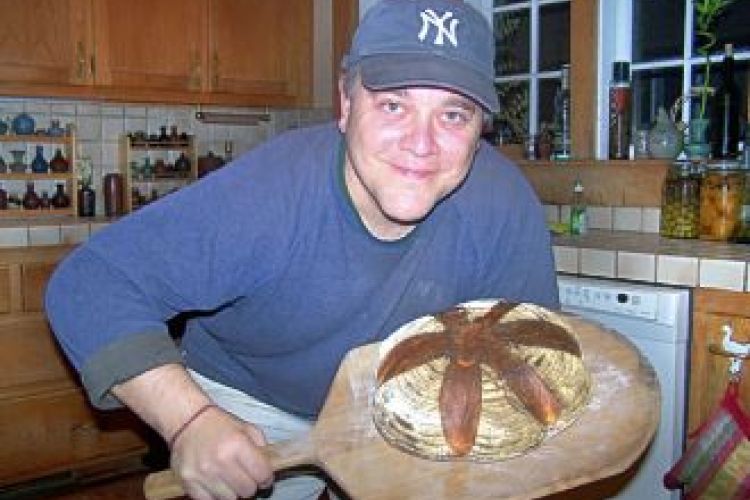Breadcrumb
Talking bread with Professor Ken Albala, the “Sourdough Whisperer”

Ken Albala, professor of history and author of two dozen food-related books.
The foundation was set, Professor Ken Albala says, starting with “10 years of anti-bread propaganda, of getting blamed each time a belly hung over a belt.”
Next came the preponderance of “hipster-do-it-yourself cooks.”
Finally, sheltering in place during the COVID-19 pandemic, people are suffering from cabin fever and looking for something to do.
And let’s face it: You can’t beat the wonderful smell and taste of homemade bread.
“So, basically, everything lined up for sourdough to be the cooking craze,” said Albala, professor of history at University of the Pacific and author of two dozen cooking and food history books. “People need things to do. So, it is really taking off.”
Albala has been in demand from media outlets to talk about sourdough starters and bread baking.
He took time to answer questions, and share his “how-to” guide.
How did you become Stockton’s resident “Sourdough Whisperer?”
Albala: I have been at it for a while. Really for the past decade. The process is interesting and the result is often delicious. There are differences each time you bake.
What draws people more, the taste of homemade sourdough bread or the process?
Albala: It is a combination of both. The process is a big part of it because people are intrigued with the concept of sourdough starters.
What is the biggest misconception—or fear—from neophyte sourdough bakers?”
Albala: There is a huge misconception. This is not as difficult as people think. They get so worried and paranoid. Many have this belief that your sourdough starter must be traced all the way back to California Gold Rush miners. Two weeks is all you really need.
What is harder to find at grocery stores, toilet paper or yeast?
Albala: (Chuckling). Oh, you can find toilet paper easily now. Good luck trying to find some yeast.
Why now for this craze?
Albala: If you had asked me in January, I would have said the craft movement has had a good run. Bread, beer, cheeses. People were still interested, but they were flocking to high-end restaurants. They were eating Impossible burgers and drinking White Claw. But the whole COVID thing has given the artisanal movement new life. People have so much time and want to create.”
Are there other current food/beverage rages overshadowed by the sourdough “movement?”
Albala: Yes, people are pickling things like crazy. It really is taking off.
What happens when the pandemic dies down or goes away? Will sourdough be a fad?
Albala: I do not think it will die out. It is enjoyable and people like the process and the result. However, people will go back to restaurants with a vengeance when this is over. Some will keep baking bread. Others will head straight to Boudin.
How to make your sourdough starter and bake great bread
By Ken Albala, professor of history, author of two dozen food-related books and resident bread-ologist.
The other day a friend asked me if I could send some sourdough starter, given that she was stuck at home and wanted to bake some great bread. She had never baked before. I told her I could, but the sourdough would very quickly change to whatever bacteria and yeast were living in her house, on her hands and even more importantly in the flour she used.
The idea that people keep old sourdough starters going for years and take them with them as heirlooms from their ancestors is largely bunk. A good starter will live forever, or I should say they will live forever, a symbiotic community of microbes. But they will also change wherever you take them, from season to season and depending on the love you give them. Like children, they will not thrive without your adoration.
My first advice to my friend was to name your sourdough. Mine is St. Agatha, the patron saint of the day my starter was born.
Here is what I told her: Take a cup of flour and a cup of water (preferably not from the tap), and mix them in a big bowl; cover with a dishcloth. Leave it on the counter, not in the fridge. Every day, add a tablespoon or two of flour and more water to the bowl. Sing to it in the morning and feed it like your pet. Some like Schubert lieder, but others adore a good Verdi aria. Depends on what kind of bread you want.
Seriously, just keep going every morning for two weeks. It will start to bubble and squeak. Your starter may smell like vomit at some point. That doesn’t mean you should throw it away. It’s like all babies at this stage. In two weeks, you are ready to bake. You should never need to throw any of it away, despite what experts say.
Now you are ready to bake. You will have nearly a big bowl full of starter. Use a third of it, add a cup of water and enough flour to make a firm dough. Do not even think of putting commercial yeast in it. You have your own local yeast. Add a tablespoon of salt. (Feed the remainder of the starter, of course, and keep on the counter.)
Knead, press, squash the dough 20 minutes to release all pent-up frustration. Put your dough in a big floured bowl and let rest for 3 hours, covered with cloth. Then take out and knead again for a while, stretching, pulling, beating the dough into submission. Place again in a well-floured bowl.
After about 15 hours you let it rise (overnight of course), preheat the oven to 500 degrees, place the dough on a parchment-lined baking sheet, slash the top of the dough with a sharp knife or cut with scissors. Don’t worry if it flattens a bit. Put it in the oven and throw a few ice cubes in the bottom to make steam. After maybe 25 minutes or so, take it out and let it rest. Don’t be tempted to eat it for a few hours.
This is basically what I told my friend and she wrote back in amazement at how good the bread came out.





